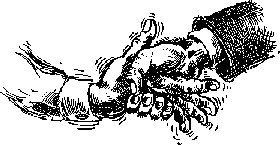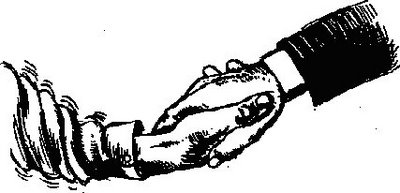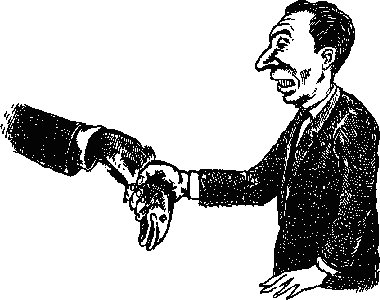Though it might seem quite perfunctory, the three-second ritual of shaking hands can provide you with as much information about the other person as a psychological profile, if you know how to read the signs. Access to this data is easily available to you insofar as this simple gesture is always performed before job interviews, performance evaluations, meetings, etc. By understanding the other person's body language, you can discover whether he/she is sincere or insincere, dominant or submissive, deceitful. This is because the body cannot lie no matter how much a person may try to cover up his/her true intentions.
This article describes how to interpret the messages of the most common handshakes. Such nonverbal information is an invaluable addition to whatever you may learn from another person's verbal responses, clothing, resume or work record. To interpret handshaking, you'll need to learn how to pick up the subtle signals that are sent during a handshake.
There four basic steps in this process include:
1. Engage. A proper handshake should engage the other person's full hand. This means that the web between your thumb and index finger should be touching your partner's. The hand should be flat enough so your palms are touching. This puts your hand in the proper position to give and receive messages.
2. Pause. Pausing is the key ingredient to a successful handshake. By pausing or lingering at the natural conclusion of a handshake, you are expressing sincerity and openness. The objective of the pause is to be the last one to release your hand from the handshake. As you pause, hold your hand slightly at an angle. Cup your last two fingers under slightly, with enough force to support the edge of the other person's palm. This will allow you to receive any of the information your partner sends during the conclusion of the shake. Being the last one to let go may seem awkward at first. But if you project a positive attitude with the rest of your nonverbal communicators (e.g. positive voice, good eye contact and smiling or restraining a smile), the lingering won't be offensive.
3. Observe. Pausing allows you to observe what type of handshake you're receiving. The hand is particularly suited to this kind of investigation because it has more nerve endings per square millimeter than any other part of the body, with the greatest concentration in the fingers. Observe whether the other person is pushing, pulling or twisting your hand. Notice whether he or she shakes your hand vigorously or barely moves. Is the hand warm and wet or cold and dry? Is it flexible or stiff? Alert your subconscious to be particularly aware at the moment you shake hands. Say to your subconscious: "while I'm doing what I need to do, collect the information you receive, sort and categorize it, and give it to me as I need it."
4. Remember. After the meeting, remember what the handshake was like. Ask yourself who shook first. Who let go first? Was the person nervous or relaxed? Was the handshake coherent with what he or she was saying? Compare the opening and closing handshakes. To remember more easily, make a visual image of the handshake each time you greet someone. Write down your impressions.
Once you start remembering handshakes, you can categorize them into ten basic types. These interpretations should be modified by your own observations but they are a good place to start.
The All-American
 This is the handshake used by most leaders and corporate executives. The person delivering it will look you right in the eye, fully engage your hand, smile and pump your hand two or three times. This handshake expresses a feeling of relaxed self-confidence. The person using it will be open, trustworthy and willing to listen. There's no hidden agenda here. He or she is a good "people" person and could be trusted in a highly classified position.
This is the handshake used by most leaders and corporate executives. The person delivering it will look you right in the eye, fully engage your hand, smile and pump your hand two or three times. This handshake expresses a feeling of relaxed self-confidence. The person using it will be open, trustworthy and willing to listen. There's no hidden agenda here. He or she is a good "people" person and could be trusted in a highly classified position. The Lingering Handshake
This one is firm with a warm grasp and two or more pumps. The end of the handshake pauses or lingers. The lingering quality may denote openness and sincerity, or it may suggest that the person has something up his/her sleeve. Trust your gut feeling about what the shake means. Check the person out carefully if the other signals you get warrant it. If you find that the other person is sincere, he or she will be an excellent candidate for a job or a promotion. I would recommend that you offer people a combination of the All-American and the Lingering handshake. This will send the message that you're open and friendly, while allowing you to pick up the other person's signals.
The Push-Off
Even though this grip may be firm and warm, at the end your hand is pushed or flicked away. The Push-Off can range from a slight stiff-arm to a flat-out rejection. This handshake implies that the other person has a strong need to establish his or her own territory and agenda. He or she will tend to be a stand-offish person without good "people" skills. This person will probably not make a good manager.
The Pull-In
 This person holds on to your hand to pull you closer or direct you through a door or toward a chair. This is a somewhat manipulative handshake. Because this type of person is a controller who wants things done certain way, he or she may not be a good team player. If the organization's goals conflict with this person's goals, there will be a problem.
This person holds on to your hand to pull you closer or direct you through a door or toward a chair. This is a somewhat manipulative handshake. Because this type of person is a controller who wants things done certain way, he or she may not be a good team player. If the organization's goals conflict with this person's goals, there will be a problem. The Two-Handed Shake
 During this handshake, the person's right hand will grab yours while the left hand grasps your wrist, forearm, biceps, shoulder, or neck The higher the left hand, the greater the manipulation and control. This is the favorite handshake of politicians Because it implies a quick sincerity and intimacy. This person is trying to sell you something that's not really there, e.g., "we're great buddies." He or she would probably not make a good salesperson because other people will tend not to trust this "used car salesman" shake.
During this handshake, the person's right hand will grab yours while the left hand grasps your wrist, forearm, biceps, shoulder, or neck The higher the left hand, the greater the manipulation and control. This is the favorite handshake of politicians Because it implies a quick sincerity and intimacy. This person is trying to sell you something that's not really there, e.g., "we're great buddies." He or she would probably not make a good salesperson because other people will tend not to trust this "used car salesman" shake. The Topper
 The dominant party in this handshake has his/her palm facing down in relation to the other person. Like the winner of an arm wrestling match, the hand on top is clearly in control. To retain equality, simply step into this handshake with your left foot. This handshake says "I'm in charge, I'm the Boss." It tends to be the handshake of the conventional boss or manager who manages through control. If this person is too controlling, this can limit his/her effectiveness with other people.
The dominant party in this handshake has his/her palm facing down in relation to the other person. Like the winner of an arm wrestling match, the hand on top is clearly in control. To retain equality, simply step into this handshake with your left foot. This handshake says "I'm in charge, I'm the Boss." It tends to be the handshake of the conventional boss or manager who manages through control. If this person is too controlling, this can limit his/her effectiveness with other people. The Finger Squeeze
 Like the push-off, the finger squeeze is used to keep someone at a comfortable distance. This kind of handshake will hurt your hand. This is a very insecure type of person who equates brute strength with personal power. They use their hands as weapons to dominate and overpower people. These days, some women are misguidedly using this kind of handshake.
Like the push-off, the finger squeeze is used to keep someone at a comfortable distance. This kind of handshake will hurt your hand. This is a very insecure type of person who equates brute strength with personal power. They use their hands as weapons to dominate and overpower people. These days, some women are misguidedly using this kind of handshake. The Bone Crusher
 will tend to turn other people off. However, if this person matures, he or she can be a strong leader.
will tend to turn other people off. However, if this person matures, he or she can be a strong leader.The Palm Pinch
 This person just offers you two or three fingers. It is usually given by a woman who hasn't learned how to shake hands properly or who has a fear of intimacy. This person will tend not to be very good at interpersonal skills. If you're going to promote the Bone Crusher or the Palm Pincher, you should tell them to shift to the All-American shake.
This person just offers you two or three fingers. It is usually given by a woman who hasn't learned how to shake hands properly or who has a fear of intimacy. This person will tend not to be very good at interpersonal skills. If you're going to promote the Bone Crusher or the Palm Pincher, you should tell them to shift to the All-American shake. The Twister
 In this one, the other person grabs your hand normally but aggressively twists it under his/her hand at the end. This person is saying, "We may be coming into this as equals, but in the end I'll be on top." This person can turn on you. You may think you're in control, but he/she will attempt to catch you off guard. This is a deceitful or devious type of person. Don't gloss over the Twister too lightly. The Twister is a major red flag for a serious background check This candidate may not be a good team player or a good security risk.
In this one, the other person grabs your hand normally but aggressively twists it under his/her hand at the end. This person is saying, "We may be coming into this as equals, but in the end I'll be on top." This person can turn on you. You may think you're in control, but he/she will attempt to catch you off guard. This is a deceitful or devious type of person. Don't gloss over the Twister too lightly. The Twister is a major red flag for a serious background check This candidate may not be a good team player or a good security risk. The Dead Fish
 We all know people who offer this kind of cold, clammy, indifferent handshake. It tends to drain your energy. This individual tends to be somewhat passive or apathetic. This type of employee will usually be better with computers, machines and information than with people. If he/she has good technical skills, don't promote him/her to a managerial position. Dead Fish handshakers probably won't have the energy and interest necessary for that type of work.
We all know people who offer this kind of cold, clammy, indifferent handshake. It tends to drain your energy. This individual tends to be somewhat passive or apathetic. This type of employee will usually be better with computers, machines and information than with people. If he/she has good technical skills, don't promote him/her to a managerial position. Dead Fish handshakers probably won't have the energy and interest necessary for that type of work. This information may make a useful addition to your repertoire of people skills. You may want to practice using these skills for at least three or four weeks so that they become second nature to you. By following these simple steps and fine-tuning your own interpretive powers, you'll be better prepared to make more accurate decisions about other people based on your first impressions.
Bob has produced a book and video on the handshaking concepts contained in this article.










1 comment:
gud post...
Post a Comment